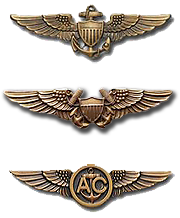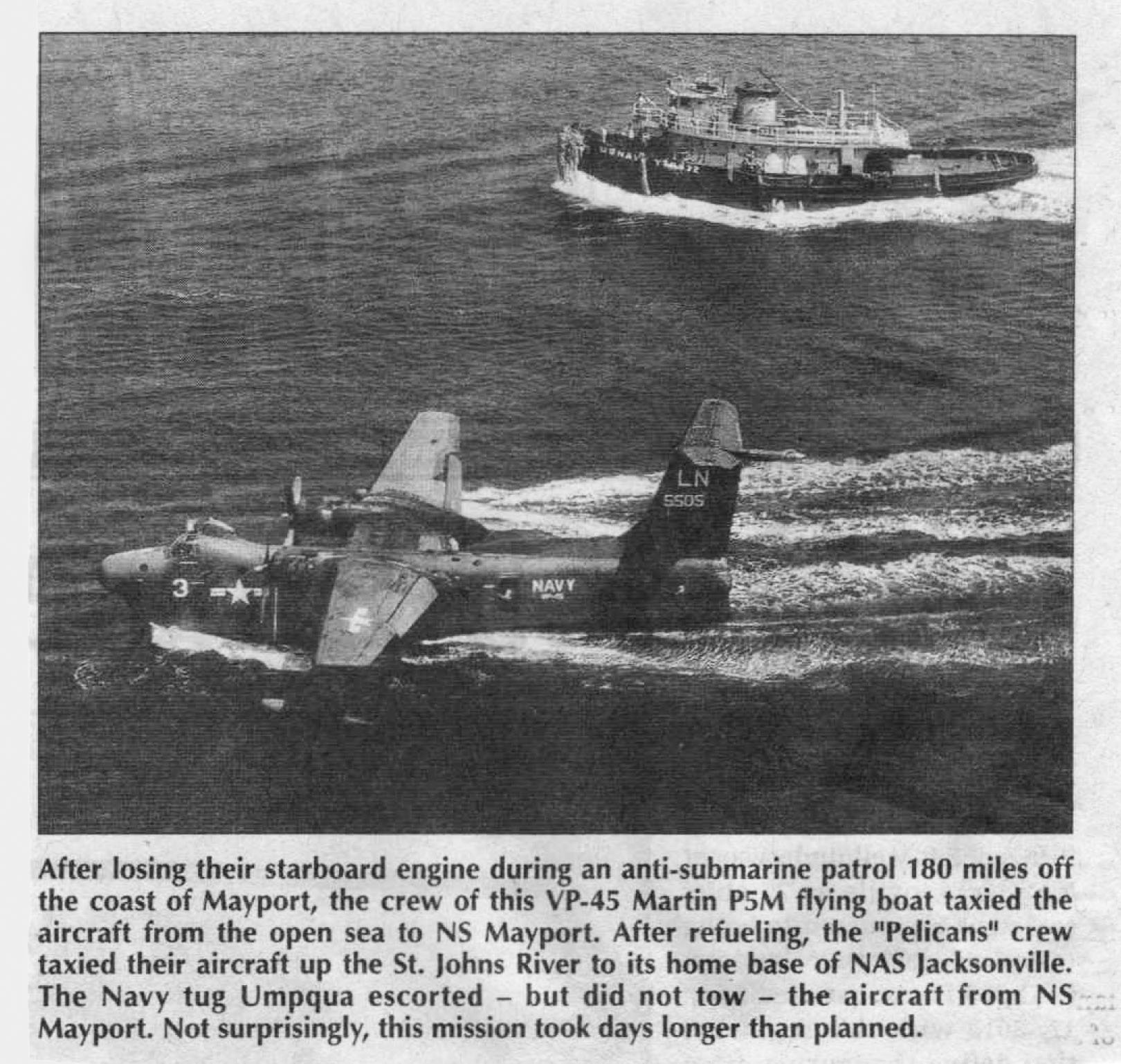180 Mile Water Taxi - 1958

Gordon Murray was the plane captain on this antisubmarine exercise flight from NAS Jacksonville on 29 July, 1958. LCDR J. S. Christensen was the PPC, Jack Callaway was co pilot and navigator was Kennedy Snow. Below is Gordon’s recollection, followed by the newspaper account and finally the epilog contributed by Jim Bestul and Lon Gailey.
"We had departed JAX early in the afternoon and reported on station about 1600 hours, releiving right on time. The weather was clear and fair — ideal. Less than thirty minutes after releiving and on station, the starboard engine exploded and began vibrating (number eleven cylinder’s intake valve), so it was secured and the prop feathered. We immediately set up for single engine operation but for some reason we could not maintain level flight; we just kept settling in and finally we landed.
then the fun began!
"We had made a smooth open sea landing, landing on top of the waves — after tapping three or four we settled in safe and sound. A complete inspection, checking for damage or hull leaks, revealed nothing to show signs of anything wrong. I even broke out the bilge pump and tested it for proper operation just in case we needed it. Mr. Christensen had ordered a message sent with position and problem prior to landing (so our situation was known by FAW-1 1), so we set a course for Jacksonville since it was the closest point of land.
"The first response came from the plane that we had just relieved. They were heading for JAX and couldn’t return due to low fuel state, but we were OK. A P2V came over and stayed a while, and the SS Ocean Monarch, a cruise ship, spent some time with us. The passengers were lining the rails watching us — the ship resumed its cruise about dark. We were doing pretty well; four to five knots in three to four foot seas and the port engine just kept turning.
"Shortly after dark a US Coast Guard cutter joined us. The cutter skipper radioed us and ordered Mr. Christensen to secure the engine and make plans to be towed. Mr. Christensen asked on whose orders…
the cutter replied on his orders. Our PPC then asked what the skipper’s rank was and the reply was LTJG. LCDR Christensen told him what his cutter could do and that, as a LCDR and PPC, the aircraft was under his command and was going to JAX under its own power -- and the cutter could follow but be sure to stay out of our way.
him what his cutter could do and that, as a LCDR and PPC, the aircraft was under his command and was going to JAX under its own power -- and the cutter could follow but be sure to stay out of our way.
"Mr. Christensen had to maintain pressure on the port hydroflap to keep the plane on course because the rudder wasn’t enough to overcome the port engine’s thrust. During the night he started having cramps in his legs. I don’t think he left the seat night, so I figured out a way to secure the pedals
he didn’t have to hold such pressure. Later on in the night we ruptured a hydraulic line in th after station and I fixed it with several lengths of flex hose, bypassing the break, refilled the system and we were on our way again. I made a pot of coffee early in the morning and Mr. Christensen seemed to really enjoy it. He, the radioman, and I were the only ones awake and the seas had settled to smooth
— everything was going OK’
"Smooth seas, making 4 - 5 knots and daylight coming on, we started picking up fishing boats and we could see they were surprised to see us. Then the coastline showed up and there were more boats. At about 0830 — 0900 we made it in to the carrier basin at Mayport, where we anchored and were relieved by another VP-45 crew to take the plane up the St. Johns River to NAS JAX . . . the end of a !cng — icng night!"
Note. The Crew consisted of the PPC, LCDR J. S. Christensen, co-pilot LTJG J. M. Callaway, navigator Ensign K. B. Snow, Gordon Murray AD1, J. J. McMahon AT3, W. E. Shreves AT3, David Johnson AE3, R. K Floyd. The trip took almost 19 hours, according to the published reports. The VP- 45 CO at the time was CDR S. A. Thomas who told the editor at the 1990 reunion that that was a very long night for him, too, being isolated from the incident at NS Bermuda and unable to do anything but pray and hope for the best!
The Jacksonville newspapers reported a few other facts: The Coast Guard cutter was CGC Aurora from Savannah accompanied by a CG P5M; the passenger liner was Ocean Monarch, enroute from New York to Bermuda and reversed course to escort the plane home, but saw it wasn’t necessary and continued on its way; that a Navy Blimp from Glynco, a helicopter and the Navy seagoing tug Umpqua also assisted. The reports also stated the speed of the aircraft was about 12 knots, and that course deviations were necessary to avoid thunderstorms in the area.
Jim Bestul discussed these events with Lon Gailey at the 1996 reunion and they remembered being part of the relief crew that took LN 3 from Mayport to NAS Jacksonville. Here is Jim’s narrative: " I had crew 1, one of three crews in Jacksonville from VP-45 (I believe for midshipman orientation flights), one of which was 3 boat and crew. Shortly after 3 boat arrived in the NAAS Mayport area after their 180 mile cruise, we made the transfer. My crew consisted of myself, Jack Archambault, Lon Gailey and several others we were not sure of but probably including Ken Ickes (Radio) and Farabaugh (Ordnance and superb mooring buoy snagger). As I recall, there was a lot of salt encrusted on the airplane; there was a big Z (the mark of Zorro) on the co-pilot’s side window, and the fuel tanks were just about empty. We got underway with a long procession consisting of Navy and Coast Guard crash boats, police boats, and many private boats that had gathered due to the news coverage of the event.
"We had 5 bridges to get under on the way to Jacksonville, a couple of them draw bridges. We got to those right at evening rush hour and, with the bridges up for our long slow-moving procession, we did a pretty good job of snarling the homebound traffic. One of the bridges was very narrow and, with Lon out on the port wing tip and another crewmember on the starboard, we inched our way through. Lon and I both remember thinking it might not even be possible, but we made it through with about a foot clearance on each side.
"The NAS Jacksonville ramp buoy was always a tough one to make even with both engines running because of the currents there, so it was going to be a real challenge with one engine. (Note: Engines could not be "blipped" to slow down as those in the PBM could because of the electrical/mechanical design, and the sea anchors were extremely difficult to deploy and trip because of the hull/hatch design.) I felt with all the spectators there and empty fuel tanks, I had better make it on the first pass. Well, I didn’t! I finally made it on the third pass and, although I was a little embarrassed, LN 3 was back!!!"
Note: Image of LN-3 above provided by Bob Johnson, AGC, USN (ret)
Send questions, comments or suggestions regarding this website to: vp45assoc@vp45association.org
Copyright © 2005 PATRON FOUR FIVE ASSOCIATION


